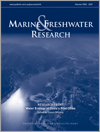Marine and Freshwater Research
Volume 70
Number 5 2019
RESEARCH FRONT: Water Ecology of China's Pilot Cities
Globally, restoration of water ecological communities (WECs) is a critical issue, especially for developing cities. China has proposed a project to build cities with healthy WECs. This Research Front brings together studies on aquatic ecosystems of the first pilot city of the project. It is anticipated this knowledge will form the basis for making aquatic ecosystem protection and restoration decisions across the globe.
After identifying keystone dominant species with a food web model, this study analysed hydrological niches for freshwater ecosystems in the first pilot city of the Water Ecological Civilisation Project in China. Excess variation in streamflow has an adverse effect on biotic communities. The methods and results of this study can facilitate aquatic ecological remediation and sustainable water resource management in numerous cities, both in China and across the world.
The temporospatial heterogeneity of the aquatic ecosystem in the first pilot city of the Water Ecological Civilisation Project in China was high. In terms of biota, species richness was higher and the community structure was more complex in 2014 than in 2015. With regard to the driving factors of the fish-community structure, the river velocity was slow, and the total nitrogen concentration was higher in the plains areas than in mountain areas. This study can provide a scientific reference for aquatic ecological rehabilitation in developing countries.
Through canonical correlation analysis, this study showed the key physical, chemical and hydrological factors affecting water quality and the health of the fish community in the first pilot city for the Water Ecological Civilisation Project in China were turbidity, chemical oxygen demand and discharge respectively. The findings can provide a reference for aquatic ecological rehabilitation in developing countries.
We constructed a plankton health assessment model based on the Shannon–Wiener diversity index that we used to analyse the temporal and spatial distribution of plankton in the first pilot city of the Water Ecological Civilisation Project, China. Water ecosystem health status was significantly better in the north and south than in the city centre, and better in spring than summer and autumn. This method can serve as a reference for aquatic ecosystem evaluation in developing countries.
Niche analysis was performed to study the niche breadth and overlap between key species and water quality factors. The results of the study provide a reliable theoretical basis for ecological restoration and water resources management.
Based on ecosystem models, this study developed a practical methodology to comprehensively assess the effects of habitat changes on aquatic biodiversity. It is anticipated that this model will help assess the effects of changes due to climate- and human-induced stress on aquatic ecosystems and provide a scientific basis for policy decisions of river administrators and stakeholders worldwide.
This study shows that the presence of a river dam did not increase the dietary preference of the European catfish towards anadromous fish prey. The proportion of marine-derived carbon (stable isotope analysis) in the diet was similar (on average 53%) between catfish individuals caught downstream of the dam and those caught in the free running part of the river. Within the context of the decline in anadromous fish populations, this significant predation is concerning.
Evidence found in results of studies of latitudinal gradients of benthic macroinvertebrate diversity is variable. In this study, we found that species and genus richness decreased and the composition of caddisfly assemblages (Insecta: Trichoptera) varied in Argentinean mountain forest through a latitudinal gradient from 22 to 28°S. This pattern is of particular note because a latitudinal gradient of aquatic insect diversity is rarely observed in a narrow range.
We studied the characteristics of dissolved organic matter (DOM) in streams from two different regions (Pampa and Patagonia) in Argentina. Dissolved organic carbon and absorption coefficients were higher in the Pampa region. In contrast, the Patagonian region showed ultra-oligotrophic conditions. Interestingly, no indications of DOM photodegradation were observed in either region.
We compiled incidents of crocodile attacks on the Gulf of Mexico and Mexican Pacific coast. In total, 102 cases corresponded to the Mexican Pacific coast and 47 to the Gulf of Mexico. The municipalities of high risk (hotspot areas) were Puerto Vallarta, Lázaro Cárdenas and Pinotepa Nacional in the Mexican Pacific coast, and, in the Gulf of Mexico, only Bénito Juárez was of high risk.
Environments with different trophic states modify the phytoplankton–zooplankton relationship. This study analysed the phytoplankton–zooplankton interaction in two tropical reservoirs with different trophic states, and that the results showed the effects of zooplankton herbivory (primarily Copepoda Calanoida) on phytoplankton groups. Thus, we suggest that Calanoida can efficiently reduce the biomass of different morphofunctional groups in freshwater tropical ecosystems.
An evaluation of aquatic invertebrate communities in debris dams and riffles in three forested headwater streams found differences in community composition between the two habitats, with debris dams containing higher numbers of the less common taxa and higher densities of shredders. However, debris dams comprised a small proportion of total habitat in these streams and when debris dams were removed from a 200-m section in each stream, no significant effects were detected in the remaining invertebrate communities.
Using stable isotope analysis and investigating the stomach contents of the endangered Maugean skate (Zearaja maugeana) in Macquarie Harbour, this study revealed that the skate occupies a high position in the food web, with a highly restricted diet consisting primarily of crabs. This highlights the vulnerability of the skate to environmental changes occurring in the harbour that may affect the availability of its prey.





